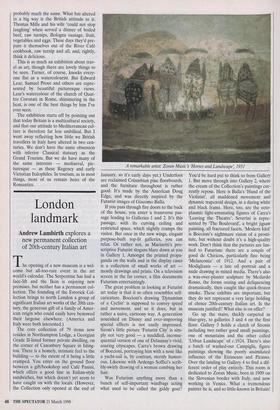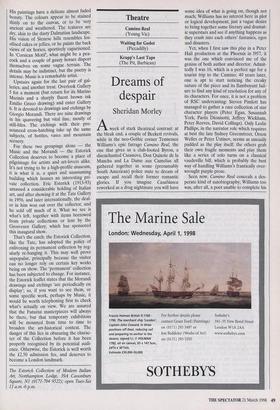London landmark
Andrew Lambirth explores a new permanent collection of 20th-century Italian art The opening of a new museum is a wel- come but all-too-rare event in the art world's calendar. The Serpentine has had a face-lift and the Ikon is enjoying new premises, but neither has a permanent col- lection. The founding of the Estorick Col- lection brings to north London a group of significant Italian art works of the 20th cen- tury, the generous gift of a family of Amer- ican origin who could easily have bestowed their largesse elsewhere. (America and Italy were both interested.) The core collection of 79 items now resides in Northampton Lodge, a Georgian Grade II-listed former private dwelling, on the corner of Canonbury Square in Isling- ton. There is a homely, intimate feel to the building — to the extent of it being a little cramped. You enter on the ground floor between a gift/bookshop and Café Panini, which offers a good line in Italian-style sandwiches, but which doesn't yet seem to have caught on with the locals. (However, the Collection only opened at the end of A remarkable artist: Zoran Music's Horses and Landscape, 1951 January, so it's early days yet.) Underfoot are reclaimed Columbian pine floorboards, and the furniture throughout is rather good. It's made by the American Doug Edge, and was directly inspired by the Futurist images of Giacomo Balla.
If you pass through fire doors to the back of the house, you enter a transverse pas- sage leading to Galleries 1 and 2. It's this passage, with its curving ceiling and restricted space, which slightly cramps the visitor. But once in the new wings, elegant purpose-built top-lit galleries, you can relax. Or rather not, as Marinetti's pro- scriptive Futurist slogans blare down at you in Gallery 1. Amongst the printed propa- ganda on the walls and in the display cases is a collection of small works of art mostly drawings and prints. On a television screen in the far corner, a film documents Futurism entertainingly.
The great problem in looking at Futurist art today is that it so often resembles self- caricature. Boccioni's drawing 'Dynamism of a Cyclist' is supposed to convey speed and movement, and so it does, but in rather a naive, cartoony way. A generation nourished on Disney and ever-improving special effects is not easily impressed. Sironi's little picture 'Futurist City' is sim- ply not very good — a muddled, inconse- quential version of one of Delaunay's vivid, soaring cityscapes. Carra's brown drawing of Boccioni, portraying him with a nose like a yacht-sail is, by contrast, sternly humor- ous. Likewise with Ardengo Soffici's scrib- bly-swirly drawing of a woman combing her hair.
Was Futurism anything more than a bunch of self-important windbags acting what used to be called the giddy goat? You'd be hard put to think so from Gallery 1. But move through into Gallery 2, where the cream of the Collection's paintings cur- rently repose. Here is Balla's 'Hand of the Violinist', all maddened movement and dynamic trapezoid design, in a daring white and black frame. Here, too, are the ecto- plasmic light-emanating figures of Carra's `Leaving the Theatre'. Severini is repre- sented by 'The Boulevard', a bright jigsaw painting, all fractured facets. 'Modem Idol' is Boccioni's nightmare vision of a prosti- tute, but without doubt it's a high-quality work. Don't think that the pictures are lim- ited to Futurism: there are a couple of good de Chiricos, particularly fine being `Melanconia' of 1912. And a pair of Modiglianis — a late oil portrait and a nude drawing in mixed media. There's also a wax-over-plaster sculpture by Medardo Rosso, the forms oozing and deliquescing dramatically, then caught like quick-frozen smoke. These exhibits are important, but they do not represent a very large holding of choice 20th-century Italian art. Is the museum justified? What else is on offer?
Go up the stairs, thickly carpeted in blue-grey, to galleries 3 and 4 on the first floor. Gallery 3 holds a clutch of Sironis including two rather good small paintings, one of mountains and the other called `Urban Landscape' of c.1924. There's also a batch of washed-out Campiglis, figure paintings showing the poorly assimilated influence of the Etruscans and Picasso. Over the landing to Gallery 4 to find a dif- ferent order of play entirely. This room is dedicated to Zoran Music, born in 1909 on the Slovenian border with Italy, and now working in Venice. What a tremendous painter he is, and so little-known in Britain! His paintings have a delicate almost faded beauty. The colours appear to be stained thinly on to the canvas, or to be very ancient and weathered. The textures are dry, akin to the dusty Dalmatian landscape. His vision of Sienese hills resembles fos- silised cakes or jellies, or he paints the back views of six horses, sportively caparisoned. In 'Corsican Motif', what might be a pea- cock and a couple of gauzy horses disport themselves on some vague terrain. The details may be indistinct, but the poetry is intense. Music is a remarkable artist.
Upstairs again for the last pair of gal- leries, and another treat. Overlook Gallery 5 for a moment (but return for its Marino Marinis and a sharply fluent brown ink Emilio Greco drawing) and enter Gallery 6. It is devoted to drawings and etchings by Giorgio Morandi. There are nine drawings in his quavering but vital line, mostly of still-lifes. The etchings with their pro- nounced cross-hatching take up the same subjects, of bottles, vases and mountain scenery. For these two groupings alone — the Music and the Morandi — the Estorick Collection deserves to become a place of Pilgrimage for artists and art-lovers alike. It's not trying to be a high-profile museum, it is what it is, a quiet and unassuming building which houses an interesting pri- vate collection. Eric Estorick (1913-93) amassed a considerable holding of Italian art, and after showing it at the Tate Gallery in 1956, and later internationally, the deal- er in him won out over the collector, and he sold off much of it. What we see is what's left, together with items borrowed from private collections or lent by the Grosvenor Gallery, which has sponsored this inaugural show. That's the catch: the Estorick Collection, like the Tate, has adopted the policy of enlivening its permanent collection by reg- ularly re-hanging it. This may well prove unpopular, principally because the visitor can no longer rely on certain key works being on show. The 'permanent' collection has been subjected to change. For instance, the Estorick leaflet states that the Morandi drawings and etchings 'are periodically on display'; so, if you want to see them, or some specific work, perhaps by Music, it would be worth telephoning first to check what's actually on view. We are assured that the Futurist masterpieces will always be there, but that temporary exhibitions will be mounted from time to time to broaden the art-historical context. The danger of this lies in obscuring the charac- ter of the Collection before it has been properly recognised by its potential audi- ence. Otherwise, the Estorick is well worth the £2.50 admission fee, and deserves to become a London landmark.
The Estorick Collection of Modern Italian Art, Northampton Lodge, 39A Canonbury Square, NI (0171-704 9522); open Tues-Sat 11 a.m.-6 p.m.





































































 Previous page
Previous page